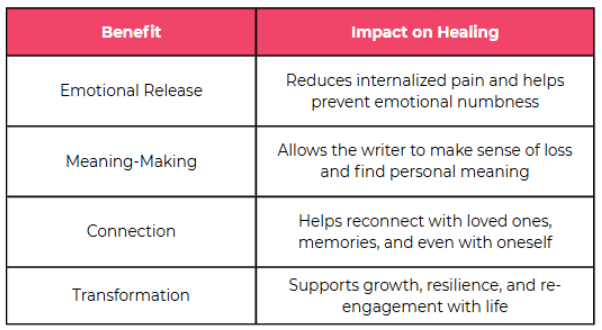April 24, 2025
The Power of Writing Through Grief: Journaling as a Tool for Healing
She Found a Journal in Her Late Husband’s Chest—What She Wrote Changed Everything
This isn’t a self-help article filled with advice and bullet points. It’s a story—a quiet one. But sometimes, the softest stories hold the deepest truths.
A lot of what I teach about grief and healing doesn’t come from textbooks—it comes from stories. Some are real. Some are imagined. All are honest. Because sometimes the only way to say something true about loss… is through fiction that lets you feel it.
This is Mary’s story.
She didn’t think she was healing.
Until one winter night, when a blank journal and a memory changed the way she carried her grief. Hers was the kind of grief that settles into your bones and makes even the smallest tasks feel impossible. Since Thomas died, the cabin hadn’t felt like home. Not really. It was still surrounded by pines, still wrapped in snow during winter, still held the same crackling fire in the hearth. But the warmth didn’t reach her. Not anymore.
Most nights, Mary just sat by the window. A cup of tea would go cold in her hands while the snow piled up outside. The silence was heavy—the kind that reminds you of everything that’s missing. People think grief is loud, all sobbing and wailing. But it’s not. It’s the quiet that hurts the most.
One night, while sorting through a chest that had belonged to Thomas, Mary found something she didn’t expect: an old leather journal. His initials were pressed into the cover, faint but unmistakable. Thomas had never mentioned keeping a journal. Her hands trembled as she opened it. Inside, there was only one entry, written the day after their wedding.
“This is for us. For the stories we will tell, the memories we will treasure, and the love that will outlive us.”
That’s it. Just that.
The rest of the pages were blank.
She didn’t know why, but she started writing. At first, it was awkward. Weather reports. What she ate. What errands she didn’t run. But over time, something shifted. The pain—the real, unspoken kind—started to make its way onto the page. Memories, regrets, moments she wished she could relive. The ache of missing him. All of it.
And somehow, in the writing, the weight she carried became just a little more bearable.
She didn’t tell anyone what she was doing. How every night she wrote to him like he was still just out walking in the woods and might come back through the door at any moment. She didn’t expect it to fix anything. She just needed a place for the ache to go.
Eventually, the cabin began to feel… different. Not fixed. Not “healed.” Just… softened. The fire stayed warm a little longer. The scent of the trees outside felt comforting instead of suffocating. And in her dreams, Thomas began to appear, sitting in the chair by the window, listening as she read her entries aloud. He never said anything. He didn’t have to.
The neighbors started noticing, too. The woman who had been quiet, withdrawn, barely visible after the funeral, smiled more now—shared a story at the market. Took a walk in the woods. But what they didn’t see was what mattered most: the ritual of showing up for her grief, night after night, pen in hand. She wasn’t writing to move on. She was writing to stay connected to him, and maybe, slowly, to herself.
Three years after Thomas’s death, she reached the end of the journal. The final page. And she wrote:
“Thank you. For the love, for the memories, and for walking me back to life.”
She closed the journal and went to bed.
The next morning, when she woke up, there was a pinecone resting gently on top of it. Just one. Small and perfectly placed. It was something Thomas used to do on hikes, slipping a pinecone into her coat pocket when she wasn’t looking. His quiet way of saying I love you without saying a word.
She cried. Of course she did.
But this time, the tears weren’t only for what she had lost. They were for what she had found, too—inside herself, and inside the silence she once feared.
Because sometimes healing doesn’t look like “moving on.”
Sometimes it looks like staying with the pain, honoring the love that never left, and slowly, slowly finding your way through.

Lessons from Mary’s Story: The Healing Power of Writing


Why Writing Through Grief Matter

Mary’s story is not just a tale—it’s a reflection of countless souls navigating the quiet, intimate path of grief. Not all of us will find pinecones on our journal, but many will find signs, memories, or simple moments of peace that remind us of love’s enduring presence. Writing doesn’t erase the grief, but it helps us carry it with grace, find meaning in the silence, and eventually, dare to live fully again.
So, when the storms of grief seem unbearable, perhaps it’s not about waiting for the wind to die down but learning to write amidst it.
OUR MISSION
We are a nonprofit founded in honor of Jenna Betti, funding programs to empower and inspire people to thrive despite adversity.
Need Support Now?


